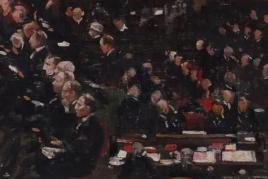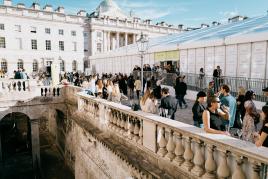This July, Sotheby’s will offer at auction Royal Orders and medals from the collection of George, Duke of Cambridge (1819-1904), King George III’s grandson. This exceptional group of objects has been passed down by direct descent, and their appearance on the market represents a unique opportunity to acquire treasures which until now have been held privately. The Orders and medals are primarily from the 2nd Duke’s collection, spanning the 19th century and the opening years of the 20th century, complemented by several pieces which were originally owned by the 1st Duke of Cambridge, the 2nd Duke’s father. Comprising approximately 80 lots with a combined pre-sale estimate in the region of £800,000, the auction will take place on 3 July 2018 at Sotheby’s London, in association with Morton & Eden, specialist auctioneers of war medals, Orders and decorations.James Morton, Morton & Eden commented: “Sotheby’s and Morton & Eden are delighted to be combining our resources and expertise to present this outstanding Royal Collection for sale. It has remained in the hands of the Duke of Cambridge’s family since his death in 1904 and has for many years been displayed publicly at the Guards Museum, Birdcage Walk. Throughout his long life, which spanned that of his cousin and close confidante Queen Victoria, George Duke of Cambridge played significant, active roles in the military, diplomatic and social evolution of the Nation. The Orders and medals offered in this auction present a unique record of service and honour, ranging from an exquisite Garter badge given personally to a young Prince in 1835 by his uncle, William IV, to the parure of insignia of the Royal House of Chakri bestowed upon the Duke by the King of Siam in 1897. The collection is further enhanced by the inclusion of a number of magnificent favourite pieces which originally belonged to the Duke’s father Adolphus, the youngest son of George III.”
H.R.H. Prince George, 2nd Duke of Cambridge, was born in 1819, the only son of H.R.H. The Prince Adolphus, 1st Duke of Cambridge (1774-1850), and the grandson of King George III (1738-1820). Cousin to Queen Victoria, the Prince was her elder by two months. However, Princess Victoria’s father, H.R.H. The Prince Edward, Duke of Kent was older than the Prince’s father Adolphus, and his seniority dictated whose child would succeed Kings George IV and William IV to the throne.
Prince George briefly served in the Hanoverian Army before becoming a Colonel in the British Army in November, 1837. Early in the Crimean campaign, he received command of the 1st Division and subsequently was present at all the major battles. Following the Crimean War he was appointed Commander-in-Chief of the Forces in 1856 and Field Marshal in November 1862. He was not afraid to confront a penny-pinching Government in matters of Army reform during his early years as Commander-in-Chief although latterly, acting partly on Queen Victoria’s personal advice, he took the decision to resign the post and did so in 1895.
Having refused to enter into an arranged marriage, in 1847 the 2nd Duke was married privately – and in contravention of the 1772 Royal Marriages Act – to Louisa Fairbrother, an actress. Ostracised by the Royal Family, the Duke’s wife was not officially titled Duchess of Cambridge and nor was she accorded the appellation ‘Her Royal Highness’. Although he had three sons with Louisa, none was entitled to inherit the Dukedom, which remained vacant following George’s death in 1904 until 2011, when Her Majesty The Queen conferred the title on her grandson, Prince William.
HIGHLIGHTS
Great Britain, The Most Noble Order of the Garter, a magnificent Lesser George Sash Badge, with central agate cameo of St George and the Dragon by Benedetto Pistrucci set in a fine 22 carat gold and blue enamel mount by William Clutton, with engraved presentation inscription on the reverseEstimate £100,000-150,000
Great Britain, Royal Guelphic Order, Military Division, Breast Star by Rundell, Bridge and Rundell, circa 1815Estimate £6,000-8,000
Great Britain, The Most Distinguished Order of Saint Michael and Saint George, a fine early Sash Badge by John Northam, 1817, in gold and enamels, with embellished red-enamelled crown suspensionEstimate £25,000-35,000
Great Britain, The Most Distinguished Order of Saint Michael and Saint George, Breast Star by Storr and Mortimer, 1838 Estimate £5,000-7,000
Russia, Order of St. Andrew, Badge in gold and enamels by Keibel, St Petersburg, from the full set of insignia bestowed upon George, Duke of Cambridge in 1874 Estimate £30,000-40,000
The Royal Hungarian Order of Saint Stephen, Grand Cross Breast Star, from the full set of insignia awarded in 1857 Estimate £8,000-10,000
 Great Britain, The Most Noble Order of the Garter, a magnificent Lesser George Sash Badge, with central agate cameo of St George and the Dragon by Benedetto Pistrucci set in a fine 22 carat gold and blue enamel mount by William Clutton, with engraved presentation inscription on the reverse Estimate £100,000-150,000 - Mit freundlicher Genehmigung von: sothebys.com
Great Britain, The Most Noble Order of the Garter, a magnificent Lesser George Sash Badge, with central agate cameo of St George and the Dragon by Benedetto Pistrucci set in a fine 22 carat gold and blue enamel mount by William Clutton, with engraved presentation inscription on the reverse Estimate £100,000-150,000 - Mit freundlicher Genehmigung von: sothebys.com






 Great Britain, The Most Distinguished Order of Saint Michael and Saint George, a fine early Sash Badge by John Northam, 1817, in gold and enamels, with embellished red- enamelled crown suspension Estimate £25,000-35,000 - Mit freundlicher Genehmigung von: sothebys.com /
Great Britain, The Most Distinguished Order of Saint Michael and Saint George, a fine early Sash Badge by John Northam, 1817, in gold and enamels, with embellished red- enamelled crown suspension Estimate £25,000-35,000 - Mit freundlicher Genehmigung von: sothebys.com /  Great Britain, The Most Distinguished Order of Saint Michael and Saint George, Breast Star by Storr and Mortimer, 1838 Estimate £5,000-7,000 - Mit freundlicher Genehmigung von: sothebys.com /
Great Britain, The Most Distinguished Order of Saint Michael and Saint George, Breast Star by Storr and Mortimer, 1838 Estimate £5,000-7,000 - Mit freundlicher Genehmigung von: sothebys.com /  Russia, Order of St. Andrew, Badge in gold and enamels by Keibel, St Petersburg, from the full set of insignia bestowed upon George, Duke of Cambridge in 1874 Estimate £30,000-40,000 - Mit freundlicher Genehmigung von: sothebys.com /
Russia, Order of St. Andrew, Badge in gold and enamels by Keibel, St Petersburg, from the full set of insignia bestowed upon George, Duke of Cambridge in 1874 Estimate £30,000-40,000 - Mit freundlicher Genehmigung von: sothebys.com /